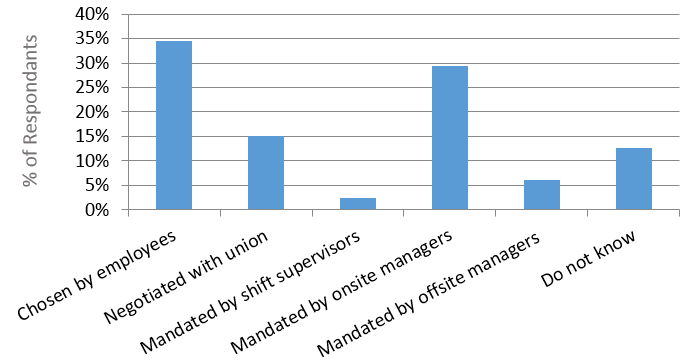Operational decisions based on shift scheduling myths can often prevent an operation from reaching its full potential in terms of operational costs, productivity, efficiency and safety.
If your operation doesn’t involve employees in work schedule changes... it may be falling prey to these myths.
Employee participation is just as important in the process of designing and implementing the new work schedule as the characteristics of the new work schedule itself.1-4
Based on 2014 Shiftwork Practices data, employee-selected work schedules and management-mandated work schedules are the two most common methods for choosing shift schedules (Figure 1).5
Schedule selection methodology can influence the degree to which the new schedule is successful.
Figure 1. Schedule Selection Methodology Across Shiftwork Operations

Costs of Management-Mandated Work Schedules
Surveys suggest that management-mandated work schedules can lead to:6
- Increased absenteeism
- Excessive overtime costs
- Increased health problems and fatigue
- Decreased morale
- Increased turnover costs
- Recruitment problems
51% of managers who mandated their work schedule reported “severe workforce fatigue,” compared to only 37% of managers in facilities where employees participated in work schedule design.6
Benefits of Employee-Chosen Work Schedules
Studies comparing methods of shift schedule selection have found that employee involvement in schedule redesign increases the benefits of schedule redesign considerably, as compared to management-mandated schedule changes.
These benefits include:7-14
1. Increased worker satisfaction with schedule design
2. Decreased unscheduled absences from illness
3. Maintained teamwork among employees as well as in-role and extra-role performance on individual levels
4. Improved physical and psychological vigor
5. Improved daytime sleep quality
6. Improved quality of employees’ home and social lives
7. Decreased turnover and number of vacant positions
8. Increased organizational commitment
9. Improved employee understanding of administrative issues involved in management of the facility
10. Reduced employee complaints
Shift Schedule Selection Tips
Employee involvement in the scheduling selection process can be critical in building strong employee-level support which in turn increases productivity and helps the company bottom line.
Each employee affected by the schedule should be equally involved in its design. Although each employee will bring his or her own preferences into the process, workforce surveys can determine the significant preferences of the facility as a whole.15
The concept of trying to “please all of the people all of the time” should be openly discussed at frequent intervals in the schedule change process, with the aim to reach a compromise that satisfies the group as a whole.
Download Our Free White Paper
Shift Scheduling & Employee Involvement
About CIRCADIAN®
CIRCADIAN® is the global leader in providing 24/7 workforce performance and safety solutions for businesses that operate around the clock. Through a unique combination of consulting expertise, research and technology, software tools and informative publications, CIRCADIAN helps organizations in the 24-hour economy optimize employee performance and reduce the inherent risks and costs of their extended hours operations.
REFERENCES
1.Hauburger. Implementation of self-scheduling in the poison center. Vet. Hum. Toxicol. 39(3),175-7. 1997.
2.Knauth P.The design of shift systems. Ergonomics 36(1-3),15-28. 1993.
3.Knauth P. Changing schedules: shiftwork. Chronobiol. Int. 14(2),159-71. 1997.
4.Kogi K, Di Martino VG. Trends in participatory process of changing shiftwork arrangements. Work & Stress 9 (2/3), 298-304. 1995.
5.CIRCADIAN, Shiftwork Practices 2014
6.CIRCADIAN® Technologies, Shiftwork Practices Survey 2002.
7. Ala-Mursula et al. Employee control over working times: associations with subjective health and sickness absences. J. Epidemiol. Community Health 56(4),272-8. 2002.
8.Beltzhoover M. Self-scheduling: an innovative approach. Nurs. Manage. 25(4),81-2. 1994.
9.Bradley, Martin. Continuous personnel scheduling algorithms: a literature review. J. Soc. Health Syst. 2(2),8-23. 1991.
10.Holtom et al. The relationship between work status congruence and work-related attitudes and behaviors. J. Appl. Psychol. 87(5),903-15. 2002.
11.Moore-Ede M. The Twenty-Four Hour Society: Understanding Human Limits in a World that Never Sleeps. 1994.
12.Smith PA et al. Change from slowly rotating 8-hour shifts to rapidly rotating 8-hour and 12-hour shifts using participative shift roster design. Scand. J. Work Environ. Health. 24(S3), 55-61. 1998.
13.Teahan. Implementation of a self-scheduling system: a solution to more than just schedules! J. Nurs. Manag. 6(6),361- 81. 998. Erratum in: J. Nurs. Manag. 7(1),65. 1999.
14.Sakai K et al. Educational and intervention strategies for improving a shift system: an experience in a disabled persons' facility. Ergonomics 36(1-3),219-25. 1993.
15.Gray et al. Preferences for specific work schedules: foundation for an expert-system scheduling program. Comput. Nurs. 11(3),115-21. 1993.


